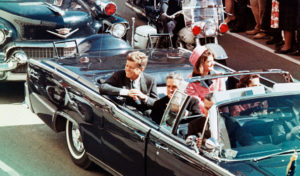Last summer, I was driving along a country road at dusk when a great, black cat appeared in front of me. Far longer than any Labrador, it slunk demurely across the path and into a hedgerow. I turned at once to my stunned companion. We both knew instinctively who she was: the fabled black panther of Oxfordshire.
I still remember her magnificent tail vanishing into a tangle of leaves. Or at least, I think I do. It’s all slightly hazy. But I don’t believe she was just a large badger, as one incredulous friend suggested. Though as a Londoner, my idea of a panther (or a badger, for that matter) is probably rather like Carpaccio’s idea of the lion of Saint Jerome. Neither of us had much experience to work with.
Perhaps I was willing it to be true, but no other explanation seemed to fit. And I wasn’t the only one to think so. Only yesterday, a construction worker claimed to have seen another legendary leopard, the Beast of Cumbria, while strolling across a field. The British Big Cats Society, meanwhile, receives reports of between 300 and 500 sightings per year, the vast majority regarding black panthers. But though I was in good company, it was still bewildering for me — a liberal “normie” in every respect — to face such a mystical assault on my Common Sense.
Believers squabble over how big cats ended up roaming the Cotswolds, but most trace the story back to the Sixties. Then, exotic pets were the height of fashion, with Harrods stocking a fine range of big cats, alligators, and even a baby elephant, which Ronald Reagan bought in 1967. But that all changed with the Dangerous Wild Animals Act of 1976, when, at least according to big cat enthusiasts, bohemians secretly released their pets into the wild to dodge the new ownership fees. Some later confessed. And in 1980, a puma was captured in the Scottish Highlands.
This theory does, admittedly, have one slight flaw: there has never been any conclusive evidence of a big cat colony in Britain. And that’s not for lack of state cooperation. In 1983, 50 of our toughest Royal Marines, aided by a pack of beagles, went hunting for the Beast of Exmoor — but they found not a whisker. Later, in 1994, after a grisly sheep massacre was blamed on the Beast of Bodmin Moor, the then-junior agricultural minister, Nicholas Soames, commissioned a six-month inquiry into the matter. The report concluded that there was “no verifiable evidence for the presence of a ‘big cat’”. More recently, in 2012, a National Trust-commissioned DNA test into a suspicious roe deer carcass, which bore the marks of a ravenous feline, pointed to a lowly fox.
And while there is some talk among Big Cat trackers of state cover-ups and leopard corpses in government freezers, this is limited to an extreme fringe. What is fascinating, in fact, is how this theory has remained largely localised, unpoliticised, and untainted. Unlike UFO sightings, it has not yet cascaded into a sinister global conspiracy, nor has it set the internet aflame with coded talk of malign forces: the World Economic Forum, the Great Reset and the global capitalist elite.
This isn’t because Big Cat theory lacks the right components. If I were to conjure my own conspiracy, I dare say I wouldn’t find it too difficult. I would simply invent a cabal of rogue Rewilders, living in splendid stately homes in the Cotswolds, who had concocted a Plot to release panthers into the wild to wipe out local livestock — and, in the spirit of the Highland Clearances, drive honest farmers from the land. These wicked Rewilders — all Davos Men, of course — would then appropriate the empty farmland, fill it with enormous peat bogs, and live royally off the lavish government Net Zero subsidies that would soon roll in. Given the scarcity of land and livestock, the poor would be herded into packed cities and forced to eat mealworm porridge instead of meat, while the rich would feast on free-roaming venison and frolic in fields of wildflowers.
As with all the best conspiracies, mine would contain an acorn of truth. Many British farmers now fear for their livelihoods, as the Government rolls out a radical post-Brexit farming subsidy scheme that rewards green initiatives such as planting woodland or rewilding. In other words, it pays farmers to cease farming. Indeed, in order to meet the Government’s environmental targets, a quarter of UK farmland will need to be reassigned. All I’d need to do is pour this very real crisis into my potion of venomous half-truths. And there is no shortage of rage to ignite: farmers are already blockading European cities and hurling eggs at the European Parliament. How long until British farmers join the resistance?
My fantastical Plot would perfectly embody Richard Hofstadter’s definition of the “paranoid style”: “a vast and sinister conspiracy, a gigantic and yet subtle machinery of influence set in motion to undermine and destroy a way of life”. But as the real Big Cat theory has not yet spiralled in this manner, it seems more like a lost fragment of folklore than a conspiracy.
There is a certain romance in this idea. While British folklore largely died out after the Enlightenment, it still evokes a pre-industrial age before trains, television and 4G stripped the nation of its cultural diversity, belittled its local beliefs, customs and dialects, and forged a Great British Monoculture. Those were the days when Britain’s peripheries weren’t pining to resemble its centre; when people didn’t drink from the same fountain of knowledge, but from their own unwieldy springs. And if hobgoblins were said to wander the forests of one remote county, an outsider would hardly dare to suggest otherwise.
It was a time most tenderly depicted by George Eliot in Silas Marner. She writes that, “to the peasants of old times, the world outside their own direct experience was a region of vagueness and mystery”. And her heart aches for those rare few who are forced to leave their native towns for a “new land where the beings around them know nothing of their history, and share none of their ideas — where their mother earth shows another lap, and human life has other forms than those on which their souls have been nourished”. It was as if other realms were ruled by different gods.
This dappled land didn’t just vanish. It was crushed by middle-class Victorians in their quest to rid the nation of uncivilised superstition, and to forever replace the scourge of Magic with Enlightenment Science and Reason. The idea that “primitive” belief systems lingered not just in the colonies, but at home too, haunted the intellectuals of the age — and led to the creation of folklore as a field of study. It ultimately came down to class: the historian Thomas Waters argues that there was a “growing sense that supernatural credulity was a distinctly proletarian trait”. And that middle-class Victorians, having been enfranchised in the 1832 Great Reform Act, were seeking to define themselves through their devotion to reason.
We can see Big Cat theory, then, as a vestige of this bygone world; a bottled cry against industrialisation. After all, as The Economist’s Jem Bartholomew argues, “the mythical beasts of the British imagination often appear at moments of modernisation”. Early sightings of the Loch Ness Monster, for instance, coincided with an upgrade to the Highlands road network. And after the Second World War, fearsome felines seem to have kept local tabloids in business, from the Beast of Bodmin Moor and the Cougar of Cupar to the Fen Tiger, the Nottingham Lion and the Sydenham Panther. Nowadays, when most British children will never know the song of a turtle dove or the scuffling of a hedgehog, the image of a panther padding over a neurotically well-tended lawn is a bewitching one.
Yet what if we have lost something more than folklore? By eroding local beliefs, ridiculing superstition, and insisting on uniformity of rational thought, we have perhaps made ourselves more, not less, vulnerable to conspiracy. Of course, the paranoid style is as old as time, its long cast of villains assuming many masks: Jesuits, Templars, Freemasons, global Capitalists, Communists. But I can’t help but wonder whether we have created a belief system so rigid and coherent that the slightest doubt can cause it all to crumble.
There once was a time when you could believe in witches, fairies, and hobgoblins, and still have absolute faith in God, Science, and your King. There were many contradictory authorities and infinite ways of seeing. But now, truth has become an all-or-nothing game: if you start to question the “Establishment” in one respect — whether over Covid vaccines, 5G or urban planning — the chances are it won’t be long until you’re drawn into an upside-down, Manichean world of conspiracy. And in this dark wonderland, as Hofstadter describes, there is “no room for mistakes, failures, or ambiguities”; everything is evidence of malicious intent. To the paranoid soul, the flick of a panther’s tail at twilight is enough to cast doubt over the entire system.
Disclaimer
Some of the posts we share are controversial and we do not necessarily agree with them in the whole extend. Sometimes we agree with the content or part of it but we do not agree with the narration or language. Nevertheless we find them somehow interesting, valuable and/or informative or we share them, because we strongly believe in freedom of speech, free press and journalism. We strongly encourage you to have a critical approach to all the content, do your own research and analysis to build your own opinion.
We would be glad to have your feedback.
Source: UnHerd Read the original article here: https://unherd.com/



